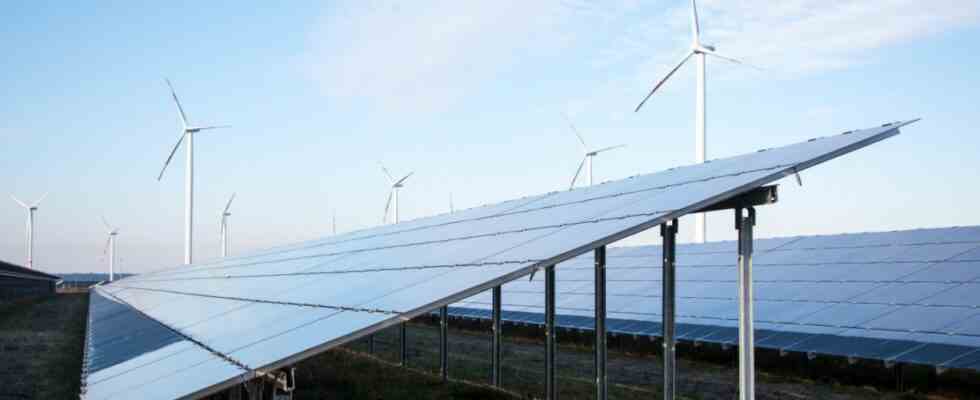A significant increase in wind and especially solar energy and a sharp drop in electricity consumption in recent months has saved the European Union from a worse energy crisis in 2022. This is the conclusion reached by British environmental and energy think tank Ember in its “European Electricity Review” analysis of the EU’s electricity market. Accordingly, wind power and photovoltaics contributed more than a fifth (22 percent) to consumption for the first time. Meanwhile, the revival of coal feared for climate reasons has largely failed to materialize.
“The energy crisis has undoubtedly accelerated the power transition in Europe,” said Dave Jones, head of Ember’s data team. Europe is on the way to a clean, electrified economy – and that will continue to gain momentum in 2023. Jones believes, “Change is coming fast, and everyone needs to be prepared for it.” Frans Timmermans, responsible for climate protection in the EU Commission, speaks of a remarkable acceleration in the expansion of renewable energies. “The numbers are particularly impressive for offshore wind turbines and solar panels on roofs.” The European Union’s goal of increasing the share of renewables to 45 percent by 2030 is ambitious, says Timmermans, but certainly achievable.
Moscow’s war of aggression in the Ukraine and the incipient decoupling of European countries from the raw material supplier Russia led to uncertainties and enormously rising prices. Although less and less natural gas flowed west from Russia over the course of the year, the share of gas in European electricity generation remained more or less stable (plus 0.8 percent). Expensive liquefied natural gas imports, especially from the USA and Qatar by ship, filled the gap.
On the other hand, production from nuclear and hydroelectric power fell sharply. The latter due to the severe drought in much of Europe. In nuclear power, Germany shut down three power plants at the end of 2021. France had to shut down almost half of its 56 reactors at times due to damage, water shortages and strikes. According to Ember, this created a gap of 185 terawatt hours (TWh), which corresponds to around seven percent of Europe’s electricity requirements in 2022. More energy from wind and solar compensated for five sixths of this gap. Only a sixth had to be replaced by fossil fuels, most of it with coal power.
The mild winter helped save electricity
Germany in particular, but also other countries, connected a total of 26 coal-fired power plants that had already been shut down to the grid. Fearing energy shortages, Europeans bought whatever they could get their hands on. After the coal embargo against Russia in August, especially in South Africa, Australia, Indonesia and Colombia. Coal imports increased by more than 50 percent compared to 2021. However, according to Ember’s analysis, two thirds of these additional imports totaling 22 million tons of coal are still in storage because they were not needed. The 26 additional coal blocks were only utilized to an average of 18 percent.
This was mainly due to a sharp drop in electricity demand in September. Until then, consumption was in the range of previous years, but it fell by almost eight percent in the last quarter. Even at the beginning of the corona pandemic, it didn’t go much further down. The mild winter in Europe helped to save electricity, and many companies and citizens felt the high prices more and more and saved. As a result, electricity generation from coal in the last four months of 2022 fell below the levels of the previous year.
The shift towards renewable energies, Ember predicts, will continue and intensify this year. This was indicated by indications from the energy sector. European wind and solar companies are expecting electricity generation to increase by 20 percent. The amount of electricity from fossil fuels is also down by 20 percent. Above all, expensive gas is being pushed out of the market. “European countries are not only still committed to phasing out coal, but are now also striving to phase out gas,” analyzes data boss Jones.
Wind turbines are more complex to install than photovoltaic modules
Above all, the boom in photovoltaics is likely to continue. Political support measures and the removal of bureaucratic hurdles mean that the share of solar energy in the electricity mix is increasing year by year in several European countries. In the Netherlands, for example, from one percent in 2015 to 14 percent now – and the trend is still rising. The situation is similar in Greece.
The upswing in wind power, on the other hand, is still a long way off. Putting a wind turbine worth several million euros in the landscape or in the sea takes longer than installing photovoltaic modules. However, there is no lack of political decisions. On Monday, the federal government agreed to quickly implement the EU’s emergency regulation for faster approval of wind turbines and power lines in particular. In the next year and a half, environmental and species protection tests can therefore be omitted on suitable areas, and the replacement of older wind turbines with more powerful new ones should be made easier. “Today the federal government launched a wind expansion accelerator that we haven’t had before,” said Federal Economics Minister Robert Habeck (Greens).
This is also necessary if the federal government wants to achieve its goals. In 2022, wind turbines with around 2.4 gigawatts were added. Now the pace of expansion must increase significantly. Five gigawatts were actually supposed to be newly installed this year, but the industry doubts that this can be implemented. By 2024 it should be eight gigawatts and from 2025 ten gigawatts a year. A gigantic project, but probably necessary, if Germany wants to get 80 percent of the electricity consumed from renewable energies in 2030. In 2022 it was 46 percent.

